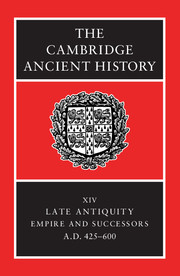Book contents
- Frontmatter
- PART I CHRONOLOGICAL OVERVIEW
- PART II GOVERNMENT AND INSTITUTIONS
- 6 Emperor and court
- 7 Government and administration
- 8 Administration and politics in the cities of the fifth to the mid seventh century: 425–640
- 9 Roman law
- 10 Law in the western kingdoms between the fifth and the seventh century
- 11 The army, c. 420–602
- PART III EAST AND WEST: ECONOMY AND SOCIETY
- PART IV THE PROVINCES AND THE NON-ROMAN WORLD
- PART V RELIGION AND CULTURE
- Conclusion
- Chronological Table
- BIBLIOGRAPHY
- Index
- References
11 - The army, c. 420–602
from PART II - GOVERNMENT AND INSTITUTIONS
Published online by Cambridge University Press: 28 March 2008
- Frontmatter
- PART I CHRONOLOGICAL OVERVIEW
- PART II GOVERNMENT AND INSTITUTIONS
- 6 Emperor and court
- 7 Government and administration
- 8 Administration and politics in the cities of the fifth to the mid seventh century: 425–640
- 9 Roman law
- 10 Law in the western kingdoms between the fifth and the seventh century
- 11 The army, c. 420–602
- PART III EAST AND WEST: ECONOMY AND SOCIETY
- PART IV THE PROVINCES AND THE NON-ROMAN WORLD
- PART V RELIGION AND CULTURE
- Conclusion
- Chronological Table
- BIBLIOGRAPHY
- Index
- References
Summary
The late Roman armies of the fourth and early fifth century are relatively well documented: Ammianus and other narrative historians describe them at work in their main theatres of operations on the Rhine, Danube and Persian frontiers, as well as in Britain and North Africa; the Theodosian Code preserves a range of laws pertaining to their creation, sustenance and functioning; the Notitia Dignitatum offers a view, albeit complicated by partial revision, of the structure and disposition of forces in both east and west. The year 420 marks a convenient break: between then and the Persian wars of Anastasius’ reign (502–7), recorded by Procopius and Joshua the Stylite, there is little reliable narrative of Roman military action, and no Notitia; also, there are few relevant laws, since only seven of the 175 titles in Theodosian Code vii, the book devoted to military matters, date from after 420, though eleven laws among the Novels of Theodosius II and four of Valentinian III can be added. During these years the western Roman army ceased to exist as a state institution, being superseded by the military forces of the successor kingdoms in Gaul, Spain, Africa and finally Italy, none of which maintained a standing army. In the east, however, the army, and hence the empire, survived in a recognizable form through to the early seventh century. The nature and causes of these distinct developments require explanation; but first, an overview of the late Roman army.
- Type
- Chapter
- Information
- The Cambridge Ancient History , pp. 288 - 314Publisher: Cambridge University PressPrint publication year: 2001
References
- 3
- Cited by

